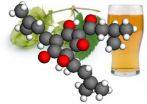(Press-News.org) Researchers employing a century-old observational technique have determined the precise configuration of humulones, substances derived from hops that give beer its distinctive flavor.
That might not sound like a big deal to the average brewmaster, but the findings overturn results reported in scientific literature in the last 40 years and could lead to new pharmaceuticals to treat diabetes, some types of cancer and other maladies.
"Now that we have the right results, what happens to the bitter hops in the beer-brewing process makes a lot more sense," said Werner Kaminsky, a University of Washington research associate professor of chemistry.
Kaminsky is the lead author of a paper describing the findings, published this month in the journal Angewandte Chemie International Edition.
There is documentation that beer and its bittering acids, in moderation, have beneficial effects on diabetes, some forms of cancer, inflammation and perhaps even weight loss.
Kaminsky used a process called X-ray crystallography to figure out the exact structure of those acids, humulone molecules and some of their derivatives, produced from hops in the brewing process. That structure is important to researchers looking for ways to incorporate those substances, and their health effects, into new pharmaceuticals.
Humulone molecules are rearranged during the brewing process to contain a ring with five carbon atoms instead of six. At the end of the process two side groups are formed that can be configured in four different ways – both groups can be above the ring or below, or they can be on opposite sides.
Which of the forms the molecule takes determines its "handedness," Kaminsky said, and that is important for understanding how a particular humulone will react with another substance. If they are paired correctly, they will fit together like a nut and bolt.
If paired incorrectly, they might not fit together at all or it could be like placing a right hand into a left-handed glove. That could produce disastrous results in pharmaceuticals.
Kaminsky cited thalidomide, which has a number of safe uses but was famously used to treat morning sickness in pregnant women in the late 1950s and early 1960s before it was discovered to cause birth defects. Molecule "handedness" in one form of the drug was responsible for the birth defects, while the orientation of molecules in another form did not appear to have the negative effects.
To determine the configuration of humulones formed in the brewing process, coauthors Jan Urban, Clinton Dahlberg and Brian Carroll of KinDex Therapeutics, a Seattle pharmaceutical firm that funded the research, recovered acids from the brewing process and purified them.
They converted the humulones to salt crystals and sent them to Kaminsky, who used X-ray crystallography – a technique developed in the early 20th century – to determine the exact configuration of the molecules.
"Now that we know which hand belongs to which molecule, we can determine which molecule goes to which bitterness taste in beer," Kaminsky said.
The authors point out that while "excessive beer consumption cannot be recommended to propagate good health, isolated humulones and their derivatives can be prescribed with documented health benefits."
Some of the compounds have been shown to affect specific illnesses, Kaminsky said, while some with a slight difference in the arrangement of carbon atoms have been ineffective.
The new research sets the stage for finding which of those humulones might be useful in new compounds to be used as medical treatments.
INFORMATION:
For more information, contact Kaminsky at 206-543-7585 or wernerka@uw.edu.
Beer's bitter compounds could help brew new medicines
2013-01-29
ELSE PRESS RELEASES FROM THIS DATE:
Annals of Internal Medicine early release article for Jan. 29, 2013
2013-01-29
Philadelphia, January 29, 2012 – The Center for Disease Control and Prevention's Advisory Committee on Immunization Practices (ACIP) announced its recommended 2013 adult immunization schedule that includes important updates to the pneumococcal, Tdap (tetanus, diphtheria, and acellular pertussis), and influenza vaccines. Because current vaccination rates are low, ACIP also urges health care providers to regularly assess patient vaccination histories and implement intervention strategies to increase adherence. This recommendation will be published in Annals of Internal Medicine, ...
Study finds significant microorganism populations in middle and upper troposphere
2013-01-29
In what is believed to be the first study of its kind, researchers used genomic techniques to document the presence of significant numbers of living microorganisms – principally bacteria – in the middle and upper troposphere, that section of the atmosphere approximately four to six miles above the Earth's surface.
Whether the microorganisms routinely inhabit this portion of the atmosphere – perhaps living on carbon compounds also found there – or whether they were simply lofted there from the Earth's surface isn't yet known. The finding is of interest to atmospheric scientists, ...
New research uncovers the neural mechanism underlying drug cravings
2013-01-29
Addiction may result from abnormal brain circuitry in the frontal cortex, the part of the brain that controls decision-making. Researchers from the RIKEN Center for Molecular Imaging Science in Japan collaborating with colleagues from the Montreal Neurological Institute of McGill University in Canada report today that the lateral and orbital regions of the frontal cortex interact during the response to a drug-related cue and that aberrant interaction between the two frontal regions may underlie addiction. Their results are published today in the journal Proceedings of ...
Hospital patient loads often at unsafe levels, physician survey says
2013-01-29
Nationwide, more than one-quarter of hospital-based general practitioners who take over for patients' primary care doctors to manage inpatient care say their average patient load exceeds safe levels multiple times per month, according to a new Johns Hopkins study. Moreover, the study found that one in five of these physicians, known as hospitalists, reports that their workload puts patients at risk for serious complications, or even death.
The research, reported in JAMA Internal Medicine, comes as health care systems anticipate an influx of new patients generated by the ...
Researchers find genes behind aggressive endometrial cancer
2013-01-29
New Haven, Conn. — In a major breakthrough for uterine serous carcinoma (USC) — a chemo-resistant, aggressive form of endometrial cancer, Yale researchers have defined the genetic landscape of USC tumors, findings that point to new treatment opportunities.
The collaborative team—which included researchers with expertise in gynecological cancer, genomics, and computational biology— identified a number of new genes that are frequently mutated in USC. The results of this comprehensive genetic analysis of USC are published in the Jan. 28 Proceedings of the National Academy ...
Slow-release 'jelly' delivers drugs better
2013-01-29
DURHAM, NC -- Duke University biomedical engineers have developed a new delivery system that overcomes the shortcomings of a promising class of peptide drugs – very small proteins – for treating diseases such as diabetes and cancer.
There are more than 40 peptide drugs approved for use in humans and more than 650 are being tested in clinical studies. One example is the hormone insulin, a peptide that regulates the metabolism of carbohydrates in the body and is used as a drug to treat diabetes.
Despite their effectiveness, peptide drugs cannot achieve their full potential ...
Public report national audit of percutaneous coronary interventional procedures 2011
2013-01-29
The 2011 annual report of the National Audit of Percutaneous Coronary Intervention (PCI) highlights the significant progress within hospitals to expand PCI services to treat more patients with acute coronary syndromes.
PCI mechanically improves blood flow to the heart and can be used to relieve the symptoms of angina, prevent and treat heart attacks. When used to treat heart attack patients, the procedure is called primary PCI. Commissioned and funded by the Healthcare Quality Improvement Partnership, the National Audit of PCI is clinically led by the British Cardiovascular ...
Cardiac disease linked to higher risk of mental impairment, Mayo Clinic finds
2013-01-29
ROCHESTER, Minn. -- Cardiac disease is associated with increased risk of mild cognitive impairment such as problems with language, thinking and judgment -- particularly among women with heart disease, a Mayo Clinic study shows. Known as nonamnestic because it doesn't include memory loss, this type of mild cognitive impairment may be a precursor to vascular and other non-Alzheimer's dementias, according to the findings published online Monday in JAMA Neurology.
Mild cognitive impairment is an important stage for early detection and intervention in dementia, says lead author, ...
New research will help shed light on role of Amazon forests in global carbon cycle
2013-01-29
The Earth's forests perform a well-known service to the planet, absorbing a great deal of the carbon dioxide pollution emitted into the atmosphere from human activities. But when trees are killed by natural disturbances, such as fire, drought or wind, their decay also releases carbon back into the atmosphere, making it critical to quantify tree mortality in order to understand the role of forests in the global climate system. Tropical old-growth forests may play a large role in this absorption service, yet tree mortality patterns for these forests are not well understood. ...
The tales teeth tell
2013-01-29
For more than two decades, scientists have relied on studies that linked juvenile primate tooth development with their weaning as a rough proxy for understanding similar developmental landmarks in the evolution of early humans. New research from Harvard, however, is challenging those conclusions by showing that tooth development and weaning aren't as closely related as previously thought.
Using a first-of-its-kind method, a team of researchers led by professors Tanya Smith and Richard Wrangham and Postdoctoral Fellow Zarin Machanda of Harvard's Department of Human Evolutionary ...



